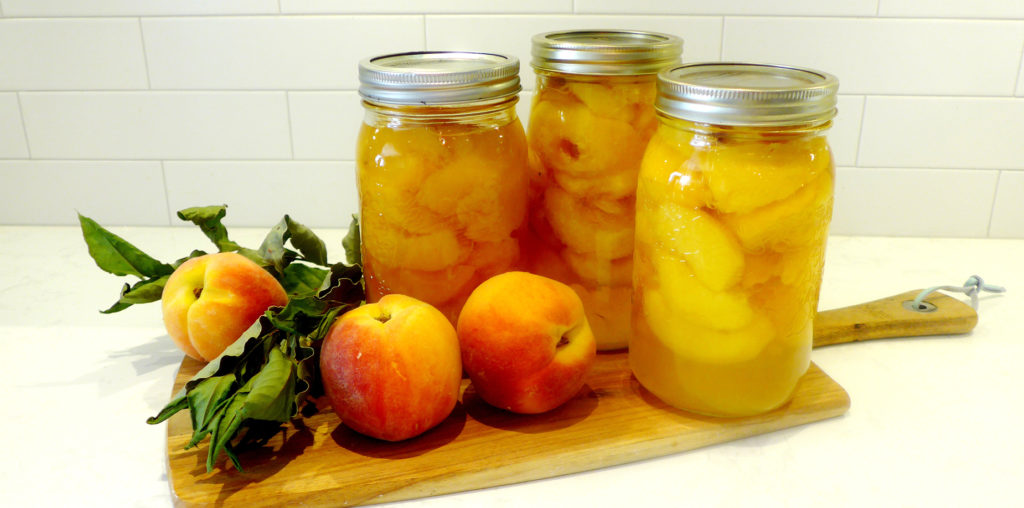by Joan Saunders –
As both my parents were teachers, we spent summers either here on the Island or in the Interior camping in a heavy, old canvas tent trailer. At the end of our journeys through the Okanagan we would load up the station wagon with boxes of fruit for mom to can when we got home. The trip back was heavily laced with the sweet, rich scents emanating from pounds of peaches, apricots, pears or cherries.
Fruit is ready when it’s ready, so mom then spent hours canning – wrapped up in steam, surrounded by bottles – as she preserved the goodness for rainy winter days.
And somehow, decades later, I find myself enveloped in a similar process. It’s not in the same quantities as my mom, but it is truly satisfying to open up a jar of peaches on a gray November day and either (as has been known to happen in our house) eat the fruit right out of the bottle with a fork or make a dessert like a crumble. It’s one way, for a moment, to savour again the sweetness of summer.
Some preserves have now become standard fare, as I usually can peaches, process chutney, make jam and pickle beets. There is something inherently gratifying about opening a cupboard and being greeted with shelves full of colourful jars of preserved fruit
and pickled deliciousness.
I first attempted canning about 30 years ago, and I knew very little about it at the time, so if I’m able to succeed at processing fruit, anyone can (pun intended). Try it; in November you’ll be extremely glad you did.
Supplies Needed
• Ripe peaches (20 pounds fills about 10 quart jars) – get Freestone if you’re able
• Sugar, water (to make sugar syrup)
• Pot to make syrup in
• Small pot to heat up lids
• Canning jars with lids and screw tops
• Baking pan
• Water bath canner
• Canning lifter
• Knife to cut up peaches
• Cutting board
• Knife to take out air bubbles
• Big bowl and boiling water
• Clean dishcloth
• Pyrex measuring cup
Light Syrup for Canning
• 2 cups sugar
• 4 cups water (I made 3 batches of this for 10 quarts)
Put in pot and heat until sugar dissolves. Keep hot on stove while preparing fruit.
Steps to Process Peaches
Clean jars and put in pan in oven to sterilize for about 20 minutes at 250°. Put lids covered in water in the small pot.
Put on low on stovetop to soften seal. Keep screw tops for later.
Put peaches in big bowl and pour boiling water over them.
This will help to remove skin. You’ll be able to tell which peaches are ready to have their skins taken off as they get a bit darker in colour.
Keep boiling more water to keep the peaches hot. Pour off cooling water as needed and add more boiling water to bowl. Pull hot jars out of oven.
Take a peach out of hot water and wash quickly with cool water. Slip off skin.
Cut along the peach’s seam, twist the fruit in half, remove the pits, cut into quarters or slices as desired.
Fill each jar with fruit. Don’t worry if peaches go a bit brown. They will change colour when processed.
Have water bath canner on stove heating up while getting jars ready. Fill 2/3 full of water.
Once jars are full of fruit, pour hot syrup over peaches in jars. (Use liquid measuring cup to do this more easily.) Leave half an inch of headspace.
Use knife to run down insides of jars a couple of times to remove air bubbles. Add more syrup if needed.
Wipe the rims with a clean cloth, seal with the lids, then screw on the bands until snug.
Place the jars in the boiling water bath canner for processing. Cover the jars with water by 1 inch. Bring the water to a soft, rolling boil with lid on. Once at soft boil, process for 30 minutes.
Turn off the heat and carefully lift out the rack and remove jars from the canner. Set jars on baking rack to cool. Lids should not bounce back if sealed. Press to check once cool.
Store jars in cool, dark place. Use within a year. Refrigerate
after opening.
I’m no canning expert; it’s just something I do. Take a look online or at cookbooks for more resources. It’s fun, it’s sticky and the results are both satisfying and very tasty; this is definitely one of those times where you can enjoy both the process and the final product
Photos by Joan Saunders




